2016 Reebok CrossFit Games RegionalsJun 21, 2016 by FloElite Staff
What If Regionals Were Scored The Old Way Part 2: The Men
What If Regionals Were Scored The Old Way Part 2: The Men
After Regionals this year, I wondered what applying the scoring system from previous Regionals—pre-2015; the same scoring used in the Open—to this year’s co

After Regionals this year, I wondered what applying the scoring system from previous Regionals—pre-2015; the same scoring used in the Open—to this year’s contests would do to the standings. After analyzing how it affected the women’s competition, I applied it to the men’s fields.
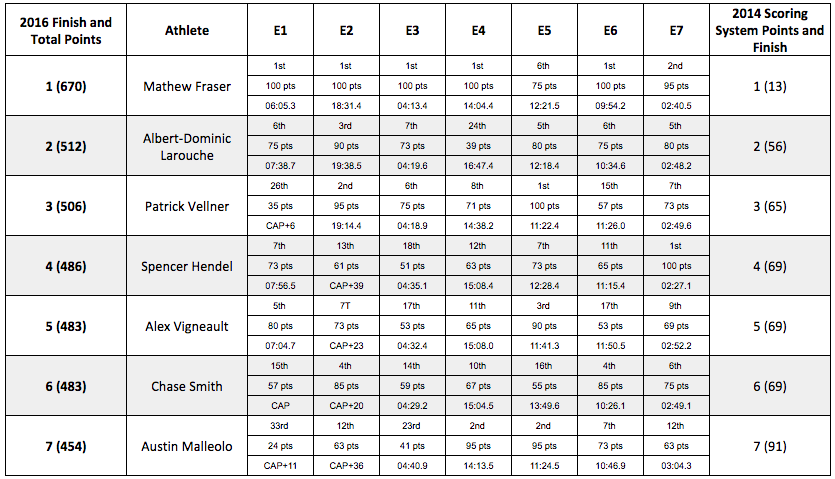
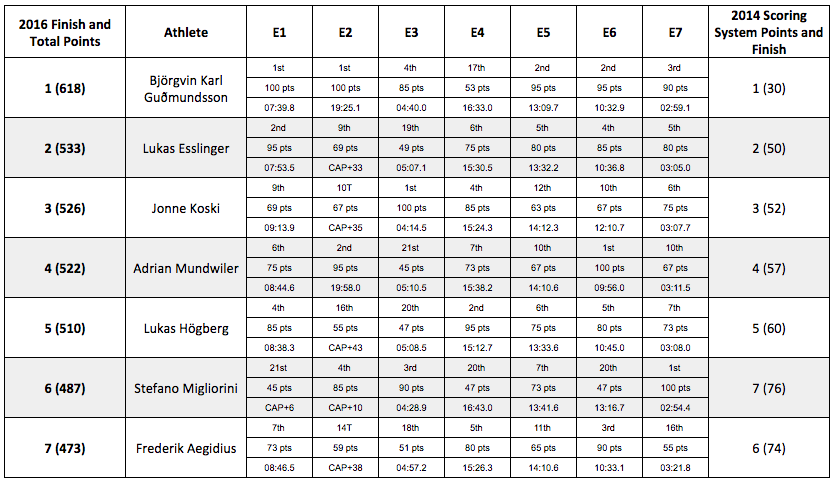
In the East, Central, and Meridian Regionals, the qualifiers did not change, and neither did their order. Each Region had an athlete who dominated the top of the leaderboard: Matt Fraser (13 total points) in the East; Scott Panchik (36) in the Central; and Bjorgvin Karl Gudmundson (30) in the Meridian. The rest of the top five remained the same.
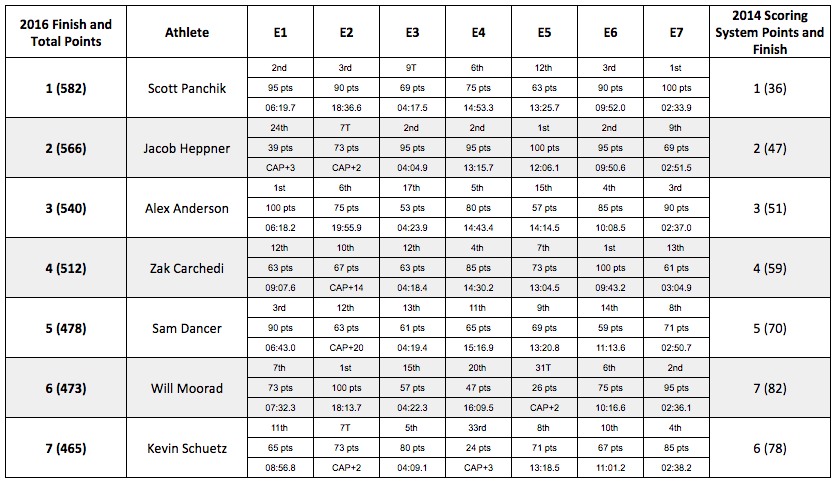
The East’s fourth and fifth sports did get interesting—the old scoring system tallied a tie between Spencer Hendel, Alex Vigneault, and Chase Smith with 69 points—but after the tie-breakers, the placing stayed the same.
In the Atlantic, California, South, and West Regionals, the finishing order of the top five shifted around, but the same athletes qualified regardless of the scoring system.
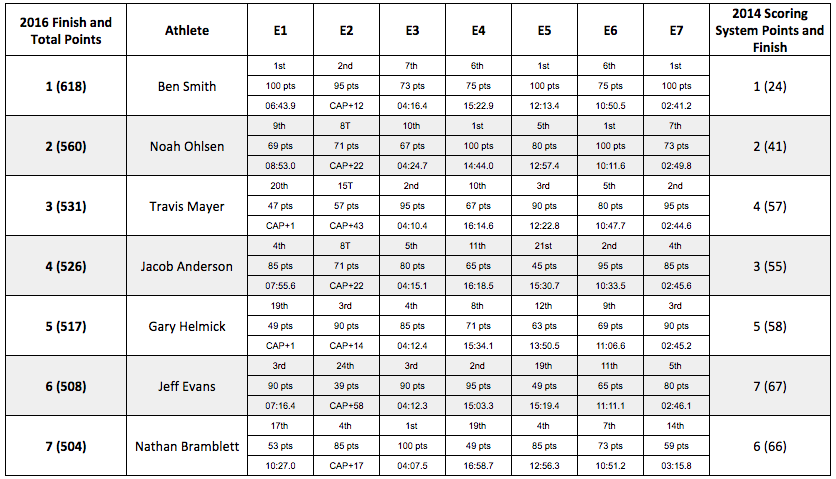
In the Atlantic, Jacob Anderson (55) jumped into third, which pushed Travis Mayer (57) back to fourth as he sustained more damage from his opening day with 20th- and 15th- place event finishes.
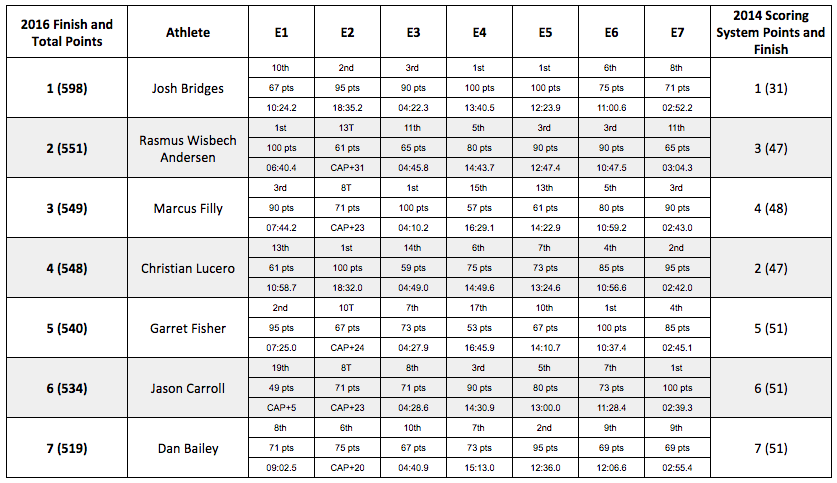
In the highly competitive California Regional, Josh Bridges (31) dominated, but things got fun after that! Christian Lucero and Rasmus Wisbech Anderson both ended up with 47 points, Lucero took the tie-breaker and moved from fourth into second on the strength of his strict gymnastics with a first in Regional Nate and second in the legless rope climbs. Marcus Filly (48) moved back to the No. 4 spot. After that, there was a three-way tie at 51 points between Garret Fisher, Jason Carroll, and Dan Bailey for the final spot. Bailey, although super-consistent with no finishes outside the top 10, was left out—his best finish was second, whereas Fisher and Carroll both had event wins. Fisher kept the fifth spot; his second-place finish on Day 1’s snatch ladder broke the tie for his second trip to Carson.
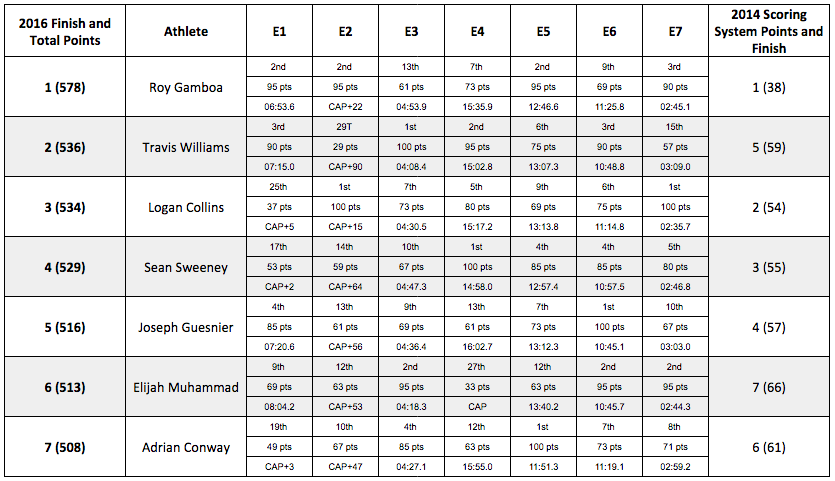
In the South, the biggest change came from runner-up Travis Williams (59), who went from second to fifth as his 29th- and 15th-place finishes in the strict gymnastics workouts, Regional Nate and legless rope climbs, did more damage to his score. The rest of the top five order just shifted up.
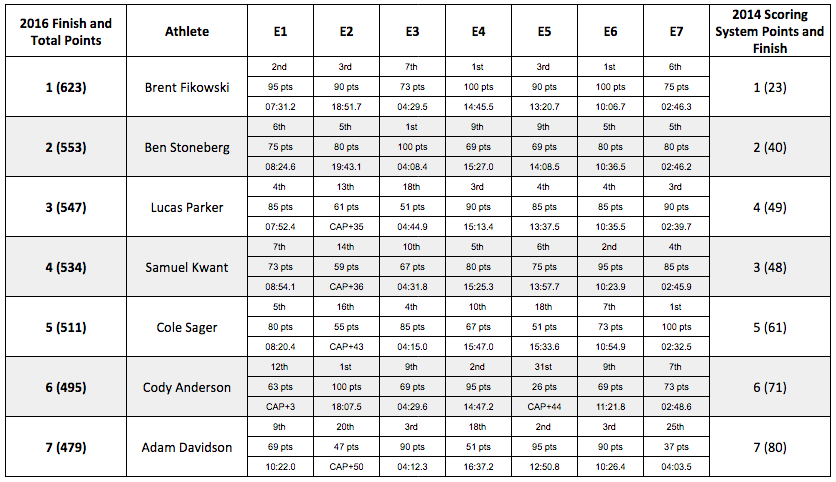
In the West, Lucas Parker (49) and Samuel Kwant (48) swapped third and fourth places, and the rest remained the same.
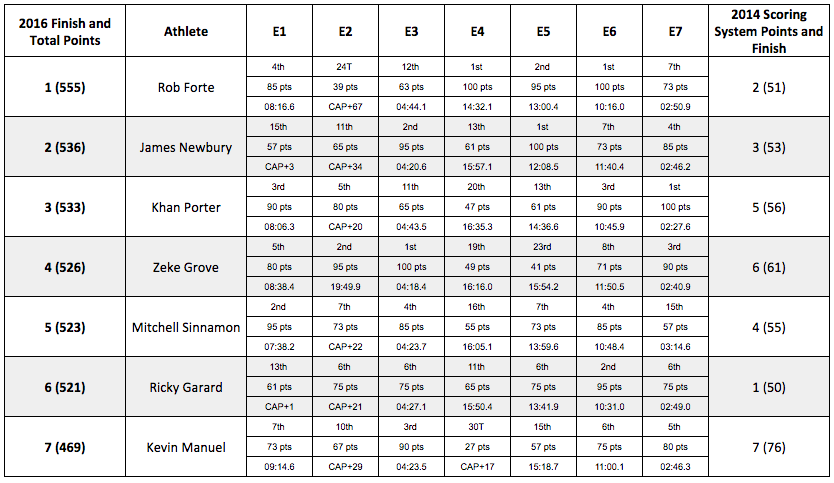
The biggest change came from the Pacific men’s competition. Here’s the list of this year’s Games qualifiers from the Pacific in the order they finished with each of their point totals: Rob Forte (51), James Newbury (53), Khan Porter (56), Zeke Grove (61), Mitchell Sinnamon (55). Not listed is this year’s sixth-place finisher Ricky Garard, who would have WON the Region with 50 points if the old scoring system was still used! With the current scoring system, the top six places in each event are separated by 5 points each, but after sixth, it goes down to a two-point spread, meaning seventh and below stay closer in point total to sixth place than the bigger separation among the top five. Garard never finished lower than 13th on any event, but took four sixth-place finishes, which made him the biggest victim of the current scoring system as he could not gain on the leaders or separate as much from the rest of the field. Zeke Grove fell from fourth place due to 19th- and 23rd- place finishes, and would not make the long trip from Australia to Carson.
After looking at these changes, you can see the differences the two systems bring to the competition and the pros and cons of both. The current system allows home-run hitters to make up for their weaknesses by awarding more points proportionately for wins than it costs for poor finishes. The pro is it makes comebacks easier, which makes the competition more exciting. The con is it allows athletes with weaknesses to pass through to the Games as long as they have major strengths. The previous scoring system rewards consistency much more. A poor finish in a weak event is proportionate to a great finish in a strong event, which makes it tougher for someone with a bad finish to make up ground for a qualifying spot. An athlete who does not necessarily win an event but is in the top 10 on all events will rank better than someone who bombs an event, but can reel off a couple wins in events that line up in their wheelhouse.
An old CrossFit Journal article highlighted the idea that the ideal fitness methodology “punishes the specialist,” but this new scoring system rewards the specialist. Neither is right or wrong—it is a competition, and the athletes play by whatever rules are in place each year. But I believe consistent athletes perform best at the Games, and a system that rewards consistency and punishes weakness may be the best determinant of who best represents each Region at the next level.
Either way you slice it, the Regionals were a blast, and I can’t wait to see this year’s CrossFit Games!
By Neal Kay
East, Central, Meridian: Nothing Changes
East

Meridian

In the East, Central, and Meridian Regionals, the qualifiers did not change, and neither did their order. Each Region had an athlete who dominated the top of the leaderboard: Matt Fraser (13 total points) in the East; Scott Panchik (36) in the Central; and Bjorgvin Karl Gudmundson (30) in the Meridian. The rest of the top five remained the same.
Central

The East’s fourth and fifth sports did get interesting—the old scoring system tallied a tie between Spencer Hendel, Alex Vigneault, and Chase Smith with 69 points—but after the tie-breakers, the placing stayed the same.
In the Atlantic, California, South, and West Regionals, the finishing order of the top five shifted around, but the same athletes qualified regardless of the scoring system.
Atlantic, California, South, West: Similar But Different
Atlantic

In the Atlantic, Jacob Anderson (55) jumped into third, which pushed Travis Mayer (57) back to fourth as he sustained more damage from his opening day with 20th- and 15th- place event finishes.
California

In the highly competitive California Regional, Josh Bridges (31) dominated, but things got fun after that! Christian Lucero and Rasmus Wisbech Anderson both ended up with 47 points, Lucero took the tie-breaker and moved from fourth into second on the strength of his strict gymnastics with a first in Regional Nate and second in the legless rope climbs. Marcus Filly (48) moved back to the No. 4 spot. After that, there was a three-way tie at 51 points between Garret Fisher, Jason Carroll, and Dan Bailey for the final spot. Bailey, although super-consistent with no finishes outside the top 10, was left out—his best finish was second, whereas Fisher and Carroll both had event wins. Fisher kept the fifth spot; his second-place finish on Day 1’s snatch ladder broke the tie for his second trip to Carson.
South

In the South, the biggest change came from runner-up Travis Williams (59), who went from second to fifth as his 29th- and 15th-place finishes in the strict gymnastics workouts, Regional Nate and legless rope climbs, did more damage to his score. The rest of the top five order just shifted up.
West

In the West, Lucas Parker (49) and Samuel Kwant (48) swapped third and fourth places, and the rest remained the same.
Pacific: Wait, WHAT

The biggest change came from the Pacific men’s competition. Here’s the list of this year’s Games qualifiers from the Pacific in the order they finished with each of their point totals: Rob Forte (51), James Newbury (53), Khan Porter (56), Zeke Grove (61), Mitchell Sinnamon (55). Not listed is this year’s sixth-place finisher Ricky Garard, who would have WON the Region with 50 points if the old scoring system was still used! With the current scoring system, the top six places in each event are separated by 5 points each, but after sixth, it goes down to a two-point spread, meaning seventh and below stay closer in point total to sixth place than the bigger separation among the top five. Garard never finished lower than 13th on any event, but took four sixth-place finishes, which made him the biggest victim of the current scoring system as he could not gain on the leaders or separate as much from the rest of the field. Zeke Grove fell from fourth place due to 19th- and 23rd- place finishes, and would not make the long trip from Australia to Carson.
After looking at these changes, you can see the differences the two systems bring to the competition and the pros and cons of both. The current system allows home-run hitters to make up for their weaknesses by awarding more points proportionately for wins than it costs for poor finishes. The pro is it makes comebacks easier, which makes the competition more exciting. The con is it allows athletes with weaknesses to pass through to the Games as long as they have major strengths. The previous scoring system rewards consistency much more. A poor finish in a weak event is proportionate to a great finish in a strong event, which makes it tougher for someone with a bad finish to make up ground for a qualifying spot. An athlete who does not necessarily win an event but is in the top 10 on all events will rank better than someone who bombs an event, but can reel off a couple wins in events that line up in their wheelhouse.
An old CrossFit Journal article highlighted the idea that the ideal fitness methodology “punishes the specialist,” but this new scoring system rewards the specialist. Neither is right or wrong—it is a competition, and the athletes play by whatever rules are in place each year. But I believe consistent athletes perform best at the Games, and a system that rewards consistency and punishes weakness may be the best determinant of who best represents each Region at the next level.
Either way you slice it, the Regionals were a blast, and I can’t wait to see this year’s CrossFit Games!
By Neal Kay